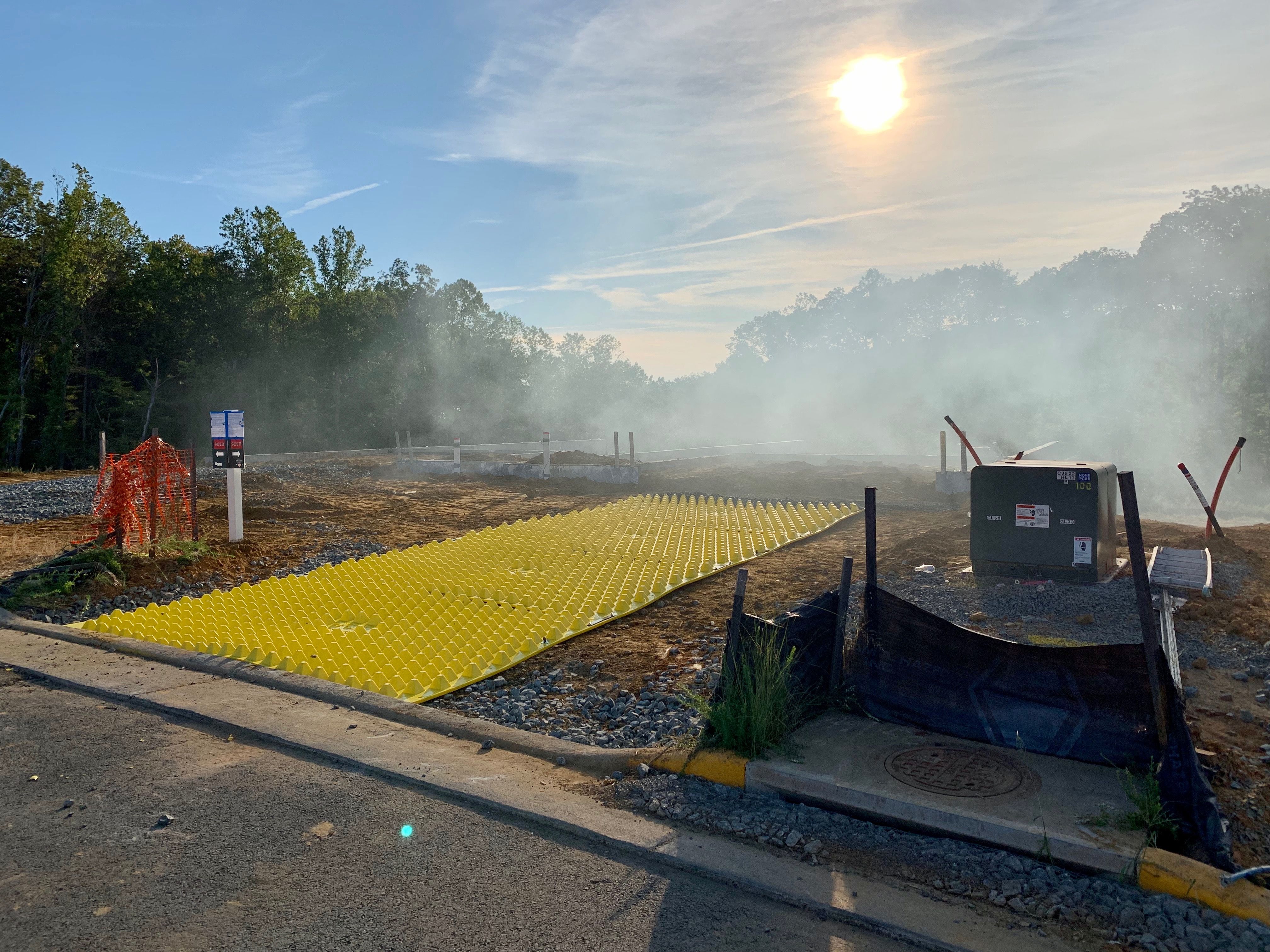North Dakota Stabilized Construction Access BMP
The Great Plains of North Dakota make up the majority of the state’s landscape and provide a sanctuary for the both wildlife and residents. The Red River of the North creates the natural border of North Dakota separating it from the neighboring state of Minnesota. This river collects the water shed of the northeastern portion of the state flowing into Lake Winnipeg and eventually empty into the Hudson Bay. Two of the states most populated cities, Fargo and Grand Forks, are both located on the banks of this river. The drainage basin of the South and West regions of North Dakota runs into the Missouri River that flows to the Gulf of Mexico.
The rich soil provides abundant returns for farmers which has led nearly every county in North Dakota to produce wheat making it the chief crop of the state. In addition, North Dakota harvests over 90% of the United States’ canola and flaxseed totals. The success of the agricultural economy in North Dakota is dependent of the purity of the water that naturally and artificially irrigates the crop. It is vital to protect this natural resource against pollutants and other activities that negatively affect the quality of the state’s water. Together, the residents, farmers, industries, and government to work together to identify possible problems and mitigate the effects on the stormwater system of North Dakota.
North Dakota Department of Environmental Quality NPDES Stormwater Permits
In 1972 the Federal government and the EPA passed the Clean Water Act (CWA) which established regulations to reduce the impact of human development on the nation’s surface waters. As a result of the act the National Pollution Discharge Elimination System (NPDES) permit program was established. The North Dakota Department of Environmental Quality (DEQ) administers the NPDES Permits within the state’s borders. The title of the state issued permit is the North Dakota Pollution Discharge Elimination System (NDPDES) permit and is handled by the Department of Environmental Quality (DEQ).
Administration of the program includes reviewing applications, issuing permits, and enforcing compliance. The permit program requires all construction and industrial site operators to apply for permit coverage before conducting activity which would disturb on or more acres of land. To obtain permit coverage operators must complete a Notice Of Intent and submit a Stormwater Pollution Prevention Plan (SWPPP). The SWPPP outlines the methods and devices that will be used on site to mitigate or eliminate the introduction of sediment, soil, and other pollutants into the public stormwater system. Creating an SWPPP first requires an operator or site engineer to identify all potential pollution sources from the construction activity will have on the surrounding land and stormwater system. The operator must then design methods and procedures to reduce or eliminate all sources of erosion and pollution. The measures and practices are called Best Management Practices or BMPs which can be both structural and procedural. Notable design features commonly implemented in an effective SWPPP include silt fences, soil retention blankets, seeding, and stabilized construction entrances.
Stabilized Construction Access Detail
The purpose of a Stabilized Construction Access BMP is to minimize sediment tracking from vehicle tires as they exit the job site. Site entrances must be stabilized prior to beginning land development and other construction activities, so the Stabilized Vehicle Exit is typically one of the first to be installed. All access points on the site which exit onto public roads must have a stabilized construction entrance.
Stabilized Construction Site Exits will require ongoing inspection and maintenance to ensure that they remain in adequate condition. In addition to the Construction Entrance BMP, operators will regularly sweep streets to capture any sediment that is tracked onto the roadway before it can enter storm drains. This combination of BMPs can ensure that sedimentation is significantly deceased.
Aggregate Style Stabilized Construction Access BMP
The North Dakota Department of Transportation’s (NDDOT) Erosion and Sediment Control Manual (ESCM) describes an aggregate style Stabilized Construction Site Exit which is comprised of a tracking pad made from large aggregate which is typically 50’ to 100’ in length. The length of the entrance should account for the largest vehicles which will be exiting the site to provide adequate tire rotations. A geotextile fabric is used to separate the aggregate from the natural soil below, and helps to prevent the aggregate from sinking into the soil. The size of the aggregate should be large enough to provide a rough surface and prevent stones from becoming stuck between dual tires.
Maintenance of an aggregate construction entrance is required when the rock becomes compacted from heavy use or saturated with sediment. To restore the aggregate pad, additional rock is used to top dress the tracking pad to restore the rough surface. Inspections should be conducted on a regular schedule and after every rain event which can cause excessive mud to be deposited onto the rock.
When a aggregate Construction Exit is not adequate to contain the majority of tracked sediment, additional or alternative BMPs may need to be installed.
Storm effects, excessive traffic, and other factors may degrade the construction exit and fail to retain sediment and soil efficiently. In this case the aggregate construction access must be supplemented by other control techniques. A common addition to any construction entrance is the wheel hose-down system.
Steel Tire Cleaning Device Construction Exit BMP
Steel rumble plates, also called shaker plates or rumble plates, are another option for reducing tracked sediment. This device is manufactured with angled steel to create a washboard effect which shakes tires to remove debris. These systems are often used in conjunction with an aggregate style entrance. Some rumble plate systems are installed over an excavated void to capture soil. Maintenance is required when mud and sediment builds up in the voids between the angled steel rows. Heavy equipment may be necessary to reposition, move, or clean the steel plates.
Wheel Wash Station BMP
A wheel wash station uses either manually operated or automated pressure washers to spray vehicle tires to remove sediment. Wheel Wash Stations require a source of power and water to operate. In addition, the sediment laden water must be diverted into a sediment basin to prevent run off from entering the roadway.
FODS Trackout Control System
FODS Trackout Control System is a modern BMP designed to minimize sediment tracking on construction sites. The system uses a consists of modular HDPE mats which are formed into pyramid shaped structures throughout the surface. The pyramids deform and flex vehicle tires in multiple directions to dislodge sediment, rocks, and debris which is lodged between tire treads. The voids between the pyramids capture sediment.
The FODS Construction Entrance Mats are durable and are designed to be reused on multiple projects over the 10+ year expected service life. Construction Entrances can be easily relocated which significantly reduces costs on phased projects and over the course of multiple projects. Installation, maintenance, and removal can be completed without the heavy equipment. The system is versatile and can be configured as needed and quickly redeployed on dirt, concrete or asphalt in under 30 minutes.
The system does not degrade during heavy use or after rain events. The 3” tall pyramids can hold up to 2.5” of sediment as the tires only come into contact with the tips of the pyramids. When maintenance is required, a pass with a street sweeper or a skid steer with broom attachment is all that is needed to restore performance. Contractors can integrate maintenance during regular street sweeping to ensure the entrance is always compliant permit requirements.
The modular FODS system outperforms traditional stone stabilized construction entrances and is commonly specified at 50% of the length of a stone stabilized tracking pad to provide equal performance. In addition, the system is both flexible and cost effective enabling contractors to reduce sedimentation and costs on each project the mats are used.
Additional Resources
North Dakota DEQ Stormwater Permits
NDDOT Erosion and Sediment Control Manual (ESCM)

